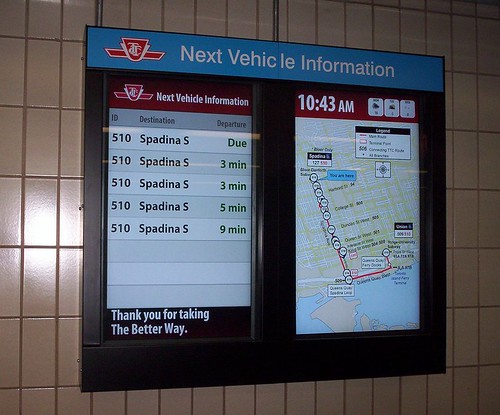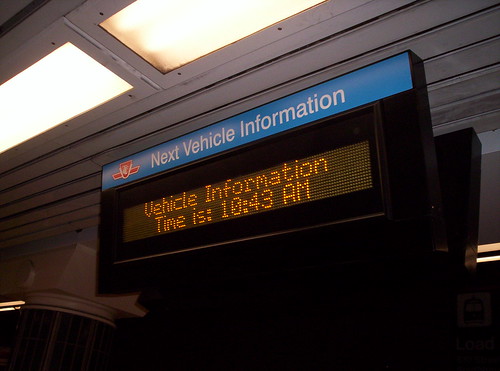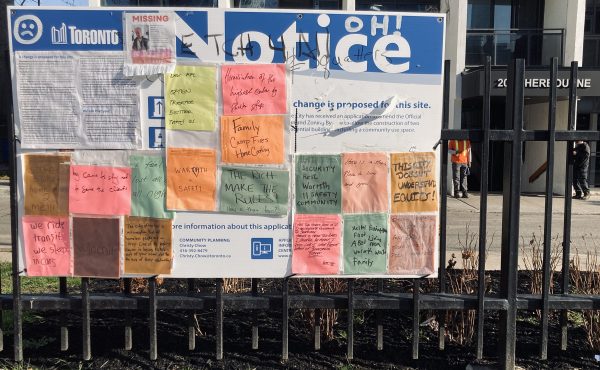
Need some confirmation of your information for your transportation (from) Spadina station? The TTC has unveiled today a new next vehicle arrival pilot project at Spadina and Union stations.
The project, which currently includes LED and LCD screens on streetcar platforms at both stations, is testing the system for the 510 streetcar route along Spadina Ave and will be introduced at other stations and shelters in the near future.
The LCD panels display a route map that shows vehicle locations in real time through the already existing GPS technology in the streetcars. Another panel gives the wait times for all incoming vehicles (in this case, just the 510). The system is based on a predictive algorithm, like traffic lights, that collect more and more data over time and become increasingly accurate. TTC Chair Adam Giambrone said at the unveiling that the system is already “pretty accurate”, being less than a minute off, but as it experiences delays in rush hour and at certain stops, it will process the information accordingly.

LED screens are also present at the two stations and will be installed at shelters and stops where they may be exposed to weather, as they are more durable than the LCD panels. The next two LED screens will be installed at College and Dundas streets along the 510 Spadina route. As the 6,000 new transit shelters were recently installed, the TTC has them pre-wired to accomodate these LED screens, so what Gimabrone called “one of the major costs” of the project has already been covered. He proposed that LED screens should be installed at select shelters across the city throughout 2009 and early 2010.
Also launching next fall will be a SMS text feature where commuters can recieve the same real-time information. TTC users will be able to sign up for e-alerts that will keep riders in touch with delays for their selected routes.



30 comments
Too bad they didn’t start the test on a line where the streetcars are less frequent/spaced further apart. Spadina, as noted on the LCD board, has a tonne of streetcars on it.
I think it would be more useful, for this particular line, to tell the folks if the streetcar is a Union, a King, or a Queen’s Quay and Spadina car; a small proportion of Spadina cars actually do the whole route.
Oh. My. God… Toronto finally enters the twentieth century with a bang.
Spadina was likely chosen because of the density of vehicles on the route in order to perfect the prediction algorithm that is being used. More data = better algorithm.
Fricking sweet. Yes, this is just one tiny sliver of what can be done, but the door has been cracked open. Release the data onslaught.
By the way, hope this turns out much better than the pilot in the New York Subway. The L train has had a lot of trouble with accuracy with its predictive software. And while Chicago is getting its Next Train screens now (http://snurl.com/8asrv), New York is still a mess: http://snurl.com/8as9s
This pilot would have been better utilized at Union Station instead of Spadina.
You do not have to wait long at Spadina for a streetcar compared to Union.
Ahhh…I hate to be the pragmatist raining on this parade, but the TTC isn’t actually going to install LCD panels everywhere are they?
A couple reasons…
#1 -Expensive
#2 -Short Lives
AND…when something breaks you have to replace the whole panel. Older LED style signage may not have the sex appeal, but if one burns out you don’t lose the whole thing.
It’s a bit fuckin’ rich for a system that’s always crying poor.
Ooopss. My bad. It IS at Union.
Sorry…I realize that I misspoke…I wrote “everywhere” and meant “anywhere”.
It makes more sense that way.
Pretty sure the signs will later on indicate if they are King, Queen, or Spadina cars. They did explain that this is a pilot and thus it’s only showing Union cars for the time being. Also, I’m sure TTC is smarter than that and would not install LCDs everywhere… That being said, I read elsewhere that it’s a Toronto-based company, Grey Island Systems, that is in charge of the prediction algorithm. I went to their website and found their link to NextBus and it turns out that they have this thing all over the States and in several cities in Canada. Either way, it was a program looooong overdue. No more freezing my butt off waiting for the streetcars lol! From now on I know when to leave the house =P
Hey, we have LCDs for *buses* in Waterloo Region! They show the real-time expected arrival of the next 2 (GPS-equipped) express buses in the relevant direction, and the scheduled times for all regular routes. These are located at all terminals with indoor facilities.
Welcome to the 21st century, Toronto. 😛
Screw the hardware. This does not help anyone at all the other stops of the line waiting in the cold/heat/wet, it helps people inside a climate-controlled station. I want accurate results I can access by my mobile device, so I can stay in the house until one is actually coming!
Josh — I believe the plan is using the LCD screens only in stations where they won’t be exposed to weather conditions. The LED screen seem to be what we’ll be seeing on the street.
If it does, as others have suggested, start a tech revolution at the TTC it’ll be good. Otherwise, what’s the point when you’re in a warm station?
Bringing the ticketing system into the 21st century would be better. But they’re probably afraid that would cost jobs, even though it would just free staff up for other things.
Wasn’t there a phone thing about ten years ago where you could call the phone number posted at your bus stop to find out when the next bus was coming? Wonder why that disappeared.
Josh  Giambrone said that every new transit shelter on streetcar routes (and presumably beyond eventually) will get the LED signs. He mentioned that all the new shelters have been pre-wired for the signs and that was part of the whole street furniture development from the beginning.
Justin — yes there was, but it only told you the next scheduled departures (kind of like the new TTC web site!), not real-time data for when the buses were actually projected to arrive.
Hamilton still uses that type of a system, but it works because their buses generally operate on time… 😉
jamesmallon — That is exactly what they are doing. This is just the first location it was installed at. There will be LED panels placed at outside shelters (which are pre-wired to accommodate them already), and there is an SMS text feature that you can use for real time info, or sign up for e-alerts which will notify you of delays. Its all in the article.
As “jamesmallon” said, this data needs to also be available in real-time over the web.. There are many ways to tap into it (read only) by 3rd parties that would be very welcome. Whether it was served via the TTC’s official site or 3rd party sites/mobile apps, this data needs to be accessible to the general public. I hope this is part of the TTC’s plan.
“Timeline” (with phone numbers posted at each stop) was killed off in 1999 because it was allegedly not Y2K compliant.
To put it simply: about time. There are a couple of things I hope the system manages to take into account. Both of these things have came up while I’ve been living in Waterloo and Cambridge over the last year, and the way the ‘next bus’ screens have worked there.
First off- if a bus is rerouted and can’t make it the actual stop, the system still keeps counting down the time until the clock suddenly jumps from 5 minutes to ‘due’ and then the bus disappears from the screen. This actually happened to me this morning and it turns out the bus broke down at Conestoga Mall and had to to be driven back to the garage via the 85.
Next off- if there’s a serious disruption to the transit system (ie. a streetcar is being rerouted, major service change coming up) then there’s no way to get that information out to riders on a LCD screen (usually).
Is the screen at the LRT loop next to the track or in the mezzanine above the subway platform?
It would make sense to me to have it on the mezzanine since it would tell you if you need to get down to the platform, and maybe reduce the crowding at the loop. Also, if you’re just heading to the Ferry Docks (or to one of the offices at Bay and Queens Quay as I sometimes am), it would help you decide whether to just walk the few blocks.
It’s really a Toronto-based company that provides this technology? That’s pretty cool!! Hoping that means great service since they probably take TTC too!
One issue related to displaying the destination of the car is that there is, at present, no data source the system can tap into to know this info. The schedule isn’t much help as cars change destinations all the time. Unlike the bus fleet where the operator punches in a code to bring up the destination display (and which could, in theory, be used to know the claimed destination), the streetcars use roll signs (which I am rather fond of even though the CLRV implementations are very poorly designed).
Until operators have a way to tell the system where their car is really going, it’s not possible for the “next car” displays to give valid info. At a location like Spadina Station there is the additional problem that the destination may not be known until the car actually arrives on the platform and the route supervisor tells the operators where to go.
I will also be interested to see whether they make provision for announcements of diversions (“all Spadina cars are at Bathurst Station today”).
Ok Trent, NextBus does the system in Guelph, and ThunderBay but not the cities you’re referring to. NextBus is a system owned by Toronto-based GPS provider Grey Island, it doesn’t send out schedule information to passengers, it uses GPS information to predict arrival information and gives passengers that info.
Check the NextBus site, it’s pretty easy to use and Guelph shows the schedule AND the predictions, so you can see there is a major difference….http://www.nextbus.com/predictor/stopSelector.jsp
The NextBus site also includes ALL of San Fran buses and streetcars, which makes it a nice predictor for the future Toronto system. Have fun playing with this (try turning various lines on and off. Streetcars are lettered.)
http://snurl.com/8h7mk
So I was at Spadina today just before 5:30… a huge crowd waiting, no streetcar in sight, and according to the display, there were two streetcars that were “due” and a few more that were just a couple minutes off.
It took about 5 minutes for a streetcar to arrive (happened to be going out of service after arriving, but another one followed immediately). That’s not necessarily a bad wait (though I’m sure it was a few minutes before I arrived), but now I’m skeptical about how accurate this thing is going to be.
Hopefully outside of rush hour it’ll be more reliable.
This is a pretty neat thing. But given the price tag of about $5m, I can’t help but think that the money could have been used for other more crucial improvements — such as actually boosting service on some routes, or maybe fixing some of the escalators that seem to be in a permanent state of disrepair. If service along a specific route is scheduled to come every 10min or so, do we really need electronic info telling us that the TTC vehicle will be here in 6 min?
Taylor- I looked at the website before going on, and I understand that GRT uses a different provider (that was obvious). GRT uses a GPS bases system too which is where my problems arises with the LED signs that will be posted at individual stops as opposed to the huge ass LCD screens that are going up at stations.
Predictive algorithm is sweet. I would also love if my iPhone had access to the same data feeds. I want to step out my door exactly as the streetcar is coming.
And yes, I know and already use the Red Rocket iPhone application, but it does not give any sort real-time issues.
That is amazing! I wish Ottawa had something like that (let alone buses for that matter)
Steve Munro – I don’t think the code punched in by the bus operators would have helped at all. At least on one bus route, the destination display often shows the wrong direction, and the drivers, or at least some drivers, just don’t care. And these TTC buses can change the destination after passengers have boarded the bus, so *any* destination info on TTC buses is actually misleading. IMHO there is a deeper “attitude” problem TTC has to fix first.
samg – Agreed. I think the first thing they should do is to actually announce traffic disruptions in both the concourse and the platform when there are traffic disruptions. And in general announce things pertinent to train arrivals/departures/delays etc instead of just doing random (and IMHO insulting) broadcasts.